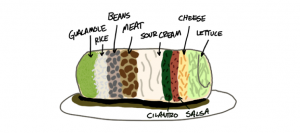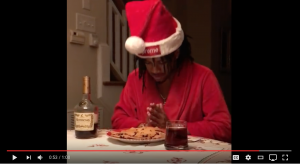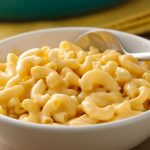Comedic Food Writing
by Michael McGehee
For my annotated bibliography, I chose to write about food media that incorporated comedy. I chose to do research on this topic because I have a very humor-driven personality, so doing research for this topic was very enjoyable for me. Below are 10 funny food-related texts/videos that I discovered. I hope that you get a laugh from them!
A) Celebrating or Memorializing
- “It’s Decorative Gourd Season, Motherfuckers” by Colin Nissan

Image courtesy of Borislav Marinic
In this text, the author celebrates the coming of Fall with an expletive-riddled piece that satirically acclaims the use of gourds as a symbol of autumn. In this piece, the author uses a great deal of profanity. However, while the repeated use of profanity can often be considered juvenile or immature, Nissan “tastefully” places vulgar language in very deliberate, properly-places spots throughout his writing, emphasizing certain points in an abrupt and comical way. The humor in his profanity stems from the fact that he uses it to convey enthusiasm and celebration rather than anger and frustration. In an interview about the text, Nissan reveals that his mother “had a mouth like a sailor”, which helps explain what may have influenced this explicit writing style. There is also a great deal of satire in this piece, poking fun at the idea of using “gourds” and “wicker baskets” as decorations that encapsulate the essence of Fall. While these are objects that have symbolized Fall for decades, Nissan pokes fun at the concept of using “mutant squash” to represent the season. Also in the interview, Nissan reveals that his father was a gourd farmer growing up, giving him a personal connection with the vegetable that he speaks so fondly about.
B) Advocating for Change
- “Dear Guy Who Just Made My Burrito:” by Darin Ross

Image courtesy of Darin Ross
Written in the form of a letter addressed to the man who prepared his food, comedian Darin Ross berates his burrito-maker’s preparation skills, implying an desperate need for a change in technique. Most have us have experienced a time in our lives where our food was not prepared to our liking, and I think that this piece is directed towards those who have also undergone this frustrating experience. Ross uses effectively uses two main comedic techniques in his text: the use of all-capitalized words and rhetorical questions. All-capitalized words and sentences are sprinkled throughout the article to convey the authors sense of anger and frustration. By using this technique sparingly instead of capitalizing everything, Ross is able to emphasize certain segments, allowing the reader to imagine the author yelling certain things as he or she reads along. The rhetorical questions are another powerful comedic tool, as they urge the reader to reflect a certain viewpoint or message. For example, when Ross says “What’s that? I should ask you to mix it up first next time?”, he is not actually asking the question with the intention of receiving a response, but rather to imply that asking the restaurant employee to mix the components of his burrito is something that he should never have to do in the first place; Ross poses this question in an attempt to convince his audience members that having to ask for this is ridiculous. These questions are delivered in such a way that conveys a sense of stupidity and ignorance in restaurant employee.
2. “Food Crimes and Their Appropriate Punishments” by Ellen Ioanes

Image courtesy of OnlyMedicineMan
In this piece, comedian Ellen Ioanes addresses several food travesties, including poor preparation techniques and terrible combinations. The most prominent comedic element in this text is the use of a very serious tone regarding matters that are very trivial. For example, Ioanes states that refrigerating tomatoes is a crime that should result in “death by guillotine”. Another punishment, regarding cooking with unclarified butter, is being “disemboweled while still alive, your putrid entrails spilling onto the new spring grass”. The author suggests highly extreme punishments, that are in no way legal for even the most horrible crimes, for very trifling kitchen mistakes. believe that this article is intended for anyone that cooks; in my opinion, it’s actually funnier to read this article if you are a violator of one of the author’s rules.
C) Selling or Marketing
- “Surviving Whole Foods” by Kelly MacLean

Image courtesy of Kelly MacLean
In this article, actress and stand-up comedian Kelly MacLean documents a typical shopping trip to Whole Foods, satirically poking fun at the demographic of people that are typically associated with shopping at the store. There is a common stereotype that Whole Foods is typically associated with healthy, hip, suburban, upper class white people. MacLean addresses this stereotype by using the reoccurring motif, “namaste” throughout the piece. She mentions seeing it on the back of a Prius in the parking lot, and again on the visor of one of the employees. She speaks of it as a pretentious mark of the customer demographic mentioned previously, a proud badge of honor for those fitness-enthused, liberal, rich caucasians who commonly inhabit Whole Foods. As stated by MacLean, “Based solely on the attitudes of people sporting namaste paraphernalia today, I’d think it was Sanskrit for “go fuck yourself.” At the end of her shopping trip, MacLean actually utters the word “namaste” herself, indicating that she has given in to the group of people that she mocks throughout the text. Another reoccurring theme that is brought up is the cost of items at the store. Such example include $108 beauty creams, $6 truffles, and $179.99 juice cleanses. All of these things are very costly and “high class”, again suggesting something about the type of people who shop at the store. Some of the humor stems from the fact that Kelly MacLean meets a lot of the criteria for the stereotypical people that shop at the store (attractive, upper class, fit), yet she is the one that is making fun of them. I think this piece is targeted towards middle and upper class shoppers who possess enough shopping knowledge to be aware of the Whole Foods stereotypes, or shoppers who frequent the store themselves.
D) Making
- Video: How To Make Vegan Blueberry Muffins with Wake Flocka Flame & Raury by Munchies

Image courtesy of The Wilma
In this instructional baking video, world-renowned rap artist Waka Flocka Flame and fellow Atlanta rapper Raury provide instructions for preparing vegan blueberry muffins. The video employs a humorous juxtaposition between the hardened, obscene, “thug” characteristics that are often associated with hip hop and rap culture with lighthearted, organic, feminine blueberry muffins. Rap culture is typically associated with delinquency and violence, exhibited in some of Waka’s own songs including hits such as “Gun Sounds” and “Smoke, Drank”. On the other hand, because meat is considered “manly”, veganism is sometimes attributed with a softer, more feminine demographic. This contrast is absolutely hilarious, seeing the tatted-up, Atlanta thug tenderly zesting a petite lemon with a gentle instrumental track playing in the background. Another comical element of this video is the lack of cooking experience and attention to detail that the two rappers use with their cooking. Although the duo manages to complete all of the steps correctly, it is evident by the sloppiness of their measuring and their perceived shortage in cooking experience that the two are not professional chiefs. I believe that this video is targeted towards a younger generation, specifically those who listen to rap music and are conscious of the norms regarding hip hop and rap culture.
2. Video: Henny Cookies by Chef Henny by Harvey J

Screenshot courtesy of Harvey J
In this short, unorthodox cooking tutorial, Harvey J, a.k.a. Chief Henny, demonstrates the “proper” way to prepare his original alcohol based delicacies. One of the strongest comical techniques that the author employs in this video is a blatantly sloppy, untraditional cooking technique and general presentation. Instead of measuring out the Hennesy, he pours it directly into the batter bag and all over the unbaked cookies on the pan. Instead of cracking the eggs gently, Chief Henny crushes both eggs together in one hand with complete disregard to any bits of shell falling into the bowl. Instead of melting the butter in the microwave, he places the butter in a metal spoon and heats it from below, as if cooking heroine. His technique is accentuated by his attire and dialect, which are also representative of his casual, untraditional methods. In the video, Chief Henney sports a Supreme Christmas hat, a luxurious red bathrobe, and gold jewelry on both wrists. Instead of provides clear verbal instructions, he gives very brief statements littered with profanity and slang. Harvey J is a self-made musician and YouTuber who creates content revolving around the popular cognac Hennessy. His audience is mostly younger people who consume a great deal of online content and are familiar with the alcohol and drug references that frequent his content.
E) Eating or Consuming
In this strongly-worded, unorthodox restaurant review, NYT critic Pete Wells brutally berates Guy Fieri’s restaurant. Wells utilizes strong imagery throughout his review to rebuke a number of Fieri’s dishes. Such examples include “…blue drink, the one that glows like nuclear waste” and “cold gray clots of ground turkey”. By using imagery in a negative manner, Wells attempts to persuade his readers of the awfulness of the food by helping them visualize the dishes in repulsive light. Similar to the burrito text that was previously discussed, this review also employs the use of rhetorical questions used to suggest Fieri’s ignorance and convince the audience of his establishments flaw’s. I know that there exists a large number of people who do not like Fieri and think that he is arrogant and aggravating. I think that this text was deliberately mean and harsh because Wells wanted to knock Fieri off his high horse, so to speak. I believe this piece was written for anyone wanting to try the restaurant or anyone who is familiar his show and therefor his personality.
2. “The Entirety of My Thoughts As I Eat My Son’s Mac and Cheese Dinner” by Maura Quint

Image courtesy of Pillsbury
“Milf is more like Macaroni I’d Like to Finish”
In this piece, Maura Quint, a mother and amateur food writer, documents her thought process as she consumes her son’s dinner. The structure of this text is unique in that it is fragmented into a number of individual thoughts, each represented with one or two sentences. Each new thought develops on the previous one, but the humor lies in that the thoughts jump from idea to idea, veering off into unrelated tangents. For example, in one sequence, Maura moves from discussing her parenting style to Hayley Joel Osment to Google to drugs; this scatterbrained, bouncing writing style is highly entertaining and engaging. I think that this text is addressed towards a very broad audience; nearly everyone has had the desire to eat a “kid’s” food that he/she used to consume at a younger age. This article may also serve to evoke nostalgia, causing the reader to remember a time in their youth when he/she consumed mac and cheese (as most kids do). As the author writes thought after thought, the amount of macaroni slowly depletes until it is finished. The piece ends with the author thinking of pizza as a replacement dinner for her son (which she also admits to loving), leaving the audience with the assumption that the author then consumed the pizza and continued her deviating, escalating train of thoughts.
3. “A Four-Year-Old Reviews the French Laundry” by Jessica Saia
“It looks really not good.”

Image courtesy of Isla Bell Murray
Although this article was not actually typed out by a 3-year-old, the content of the text is essentially the thoughts and opinions of the child, documented by quotes and photographs. Deemed “youngest person to eat a full tasting menu at the French Laundry”, this child takes on the task of critiquing one of the top ranked restaurants in all of California. The humor in this lies in the fact that restaurant reviewers are trained in their trade; they know how to assess a restaurant based on the food, staff, ambiance, etc. This is a task that takes a knowledgeable individual who has experienced a great variety of foods and restaurants in his or her lifetime, yet a clueless child is attempting to take on this job. The review is filled with comical quotes such as “It tastes like a Tinker Bell popsicle” and “I like the white part better than the green part”, accompanied by photos that show the child’s facial reactions. However, although the child’s commentary is not actually a legitimate assessment of the restaurant, the article was structured as if this was an authentic review. I think that this article is targeted towards parents, as they are able to relate to the simplistic, juvenile thought process of children.
F) Other
This piece is structured very differently from all of the other text articles that I have included thus far. The author, Alison Spiegel, is a food writer and editor for Tasting Table, previously for The Huffington Post. This article simply lists 12 pretentious food terms that are commonly used and includes one sentence criticizing each word. The comedy in this article emanates from the brevity of the statements that address each word. Instead of long, drawn out paragraphs, Spiegel states her thoughts in blunt, succinct declarations. Such examples include “Did the kitchen staff really go out and forage the mushrooms, or did they possibly buy them at a market?”, in response to the word “foraged”. I think that this article is specifically for those who are familiar with food writing, as these terms are commonly used in such texts but may be foreign to people unfamiliar. It is a quick, easy, and funny read.
Process Reflection:
As mentioned previously, I chose the topic of humor-based food articles because I am a very comedic-driven person and I wanted to do research on something that I was truly passionate about. I initially started by Googling articles with search terms such as “comedic food articles”. I then discovered a very useful tool for finding new texts: utilizing the bibliographies of other authors. After compiling a fairly long list of articles found by either using Google or by looking in other authors bibliographies (which I kept in the Notes application on my mac), I began to select which ones I wanted to use for my own bibliography. Firstly, I started by selecting articles that fit into each required category. After satisfying the diversity requirement, I chose the texts that I thought were the funniest, but also had unique attributes. For example, in “A Four-Year-Old Reviews the French Laundry”, the “author” is a child; I had never came across a text whose primary speaker was under the age of 10. I also wanted to include several videos, as YouTube is a site where I am exposed to a comedy on a daily basis. I did my best to cut out articles that were repetitive in their content and structure. My annotations were all done in Microsoft Word. I had a lot difficulty formatting my bibliography in WordPress. I spend a very long time formatting everything how I wanted it in the WordPress editing platform, but when I clicked the preview button it did not look like it did in the editing platform. After 20+ attempts at changing the format, I grew frustrated had to settle with what I had. I strongly regret trying to format in WordPress and I never intend on using this platform again.